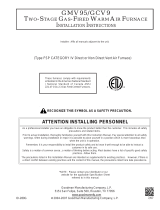
Required Volume fan_ 15ft3 ( If an )
ACH 1000 BTUH
RequiredV°lume fan_ "42m3 ( If an /
ACH .293 kW
2.
If:
For fan-assisted appliances such as this furnace,
] other = combined inputof all other than fan-assisted
appliances in BTUH
I fan = combined input of all fan-assisted appliances in
BTUH
ACH = air changes per hour (ACH shall not exceed 0.60)
The following requirements apply to the Standard Method and to
the Known Air Infiltration Rate Method.
• Adjoining rooms can be considered part of a space, if there
are no closable doors between rooms.
An attic or crawl space may be considered a space that freely
communicates with the outdoors provided there are ade-
quate ventilation openings directly to outdoors. Openings
MUST remain open and NOT have any means of being
closed off. Ventilation openings to outdoors MUST be at least
1square inch of free area per 4,000 BTUH oftotal input rating
for all gas appliances in the space.
• In spaces that use the Indoor Combustion Air Method, in-
filtration should be adequate to provide air for combustion,
ventilation and dilution of flue gases. However, in buildings
with unusually tight construction, additional air MUST
be provided using the methods described in section
titled Outdoor Combustion Air Method:
• Unusually tight construction is defined as Construction with
1. Wails and ceilings exposed to the outdoors have a con-
tinuous, sealed vapor barrier. Openings are gasketed or
sealed and
2. Doors and openabte windows are weather stripped and
3. Other openings are caulked or sealed. These include
joints around window and door frames, between sole
plates and floors, between walt-ceiling joints, between
wall panels, at penetrations for plumbing, electrical and
gas lines, etc.
VentilationAir
Some provincial codes and local municipalities require ventilation
or make-up air be brought intothe conditioned space as replace-
ment air. Whichever method isused, the mixed return air tempera-
ture across the heat exchanger MUST not fall below 60°
continuously, or 55° on an intermittent basis so that flue gases will
not condense excessively inthe heat exchanger. Excessive con-
densation will shorten the life of the heat exchanger and possibly
void your warranty.
5. Gas Vent Installation
CARBON MONOXIDE POISONING HAZARD
Failure to properly vent this furnace could result
in personal injury or death.
Use methods described here to provide combus-
tion and ventilation air.
Install the vent in compliance with codes of the country having ju-
risdiction, local codes or ordinances and these instructions.
This Category ! furnace is fan-assisted.
Category ! furnace definition: A central furnace which operates
with a non-positive vent static pressure and with a flue loss not
less than 17 percent. These furnaces are approved for common-
venting and multi-story venting with other fan-assisted or draft
hood-equipped appliances in accordance with the NFGC or
NSCNGPIC.
CategoryI SafeVentingRequirements
Category [ furnace vent installations shall be in accordance with
Parts 10 and 13 of the National Fuel Gas Code (NFGC), NFPA
54/ANSI Z223.1-2006; and/or Section 8 and Appendix C of the
CSA B149.1-05, National Standard of Canada, Natural Gas and
Propane Installation Code; the local building codes; furnace and
vent manufacturer's instructions.
NOTE: The following instructions comply with the NFPA 54/ANSI
Z223.1-2006 National Fuel Gas Code and CSA B149.1 Natural
Gas and Propane Installation code, based on the High-Heat
input rate on the furnace rating plate.
1. If a Category ! vent passes through an attic, any concealed
space or floor, use ONLY Type B or Type L double wall vent
pipe. Ifvent pipe passes through interior wall, use type Bvent
pipe with ventilated thimble ONLY.
2. Do NOT vent furnace into any chimney serving an open fire-
place or solid fuel burning appliance.
3. Use the same diameter Category ! connector or pipe as per-
mitted by:
• by the National Fuel Gas Code Code (NFGC) NFPA
54/ANSI Z223.1-2006 Sections 12 and 13 venting re-
quirements in the United States
or
• the National Standard of Canada Natural Gas and Pro-
pane Installation Code (NSCNGPIC) CSA B149.1-05
Section 8 and appendix C venting requirements in Cana-
da.
4. Push the vent connector onto the furnace flue collar of the
venter assembly until it touches the bead (at least 5/8" over-
lap) and fasten with at least two field-supplied, corrosion-re-
sistant, sheet metal screws located at least 140° apart.
5. Keep vertical Category ! vent pipe or vent connector runs as
short and direct as possible.
6. Vertical outdoor runs of Type-B or ANY single walt vent pipe
below the roof line are NOT permitted.
7. Slope all horizontal runs upwards from furnace to the vent ter-
minal a minimum of 1/4" per foot (21 mm/m).
8. Rigidly support all horizontal portions of the venting system
every 6' (1.8m)or less using proper clamps and metal straps
to prevent sagging and ensure there is no movement after
installation.
9. Check existing gas vent or chimney to ensure they meet
clearances and local codes. See Figure 1
10. The furnace MUST be connected to afactory built chimney or
vent complying with a recognized standard, or a masonry or
concrete chimney lined with a lining material acceptable to
the authority having jurisdiction. Venting into an unlined
masonry chimney or concrete chimney is prohibited.
See the Masonry Chimney Venting section in these in-
structions.
11. Fan-assisted combustion system Category ! furnaces shall
not be vented into single-wall metal vents.
12. Category ! furnaces must be vented vertically or nearly verti-
cally, unless equipped with a listed mechanical venter.
13. Vent connectors serving Category I furnaces shall not be
connected intoany portion of mechanical draft systems oper-
ating under positive pressure.
44101202301 Specifications are subject to change without notice 12




















